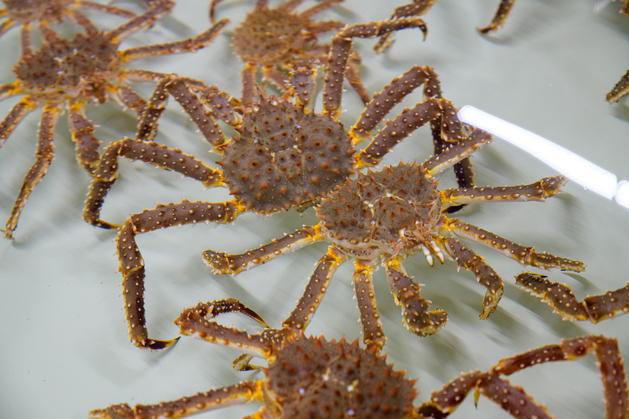Kongemat
Feeding of small king crabs using lumpfish

The main goal of this project is to test whether rlumpfish, either as a coating on dry crab food or as raw (frozen) food, can increase appetite and feed intake in juvenile king crabs and thus lead to an increased degree of meat content and value of the king crabs.
Start
15. Sep 2022
End
15. Dec 2023
Funded by
MABIT
Cooperation
Capefish (Storbukt fiskeindustri), Salmar
Project Manager(s):
Other Participants:
Anette Hustad
Sten Ivar Siikavuopio
Federico Lian
Kjersti Lian
Tina H.E. Thesslund
Background
King crab (Paralithodes camtschaticus) is highly sought after because of its tasty meat.
In 2021, Norway exported 2,261 tonnes of king crab to a value of NOK 999 million (Norwegian Seafood Council, 2022). These are record high figures, with a value increase of 50% compared to 2020.
Of all the seafood Norway exports, the king crab achieves the highest price per kg. Exports of king crab are limited to crabs of commercial size, i.e. crabs weighing more than 1.6 kg.
In the free fishing area west of 26 degrees longitude, the king crab is defined as an undesirable species. In this area, the aim is therefore to fish up as much of the crab as possible to prevent further spread westwards, and all crab caught must be transported ashore.
Crabs weighing less than 1.6 kg today are mainly either for silage or destroyed, as there are no facilities or knowledge of how to feed the crabs until they reach commercial sizes.
Lumpfish (Cyclopterus lumpus) is an important species used to combat salmon lice in the aquaculture industry. In 2020, 35 million lumpfish were used for this purpose (Fisheries Directorate).
When the lumpfish becomes sexually mature, it stops eating lice and the fish are then destroyed or used for silage. It is not unusual for the farming industry to have to pay to get rid of the lumpfish (Nøstvold et al., 2016).
There has been some discussion about the use of lumpfish as cleaning fish and whether this use should be phased out. An alternative raw material for use with juvenile king crabs can then be wild lumpfish. Wild lumpfish are fished because the roe is in demand, but here too the fish is primarily used for silage. As of 2020, Norway had approx. 650,000 kg of wild-caught round lumpfish to a value of approx. NOK 16 million (Norwegian Raw Fish Association, 2022)
In this project, we will test whether lumpfish, either as a coating on dry crab food or as raw (frozen) food, can increase appetite and meat content in the king crabs.
Sub goals
- 1: Hydrolyze lumpfish and coat dry feed.
- Objective 2: Define feeding regimes and establish protocols for monitoring.
- Objective l 3: Results collection and processing.
- Objective 4: Pilot scale experiment with 300 crabs.
- Objective 5: Presentation at a scientific conference.
Research facilities